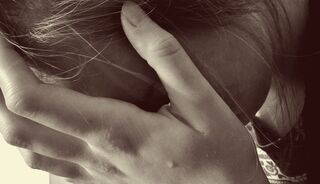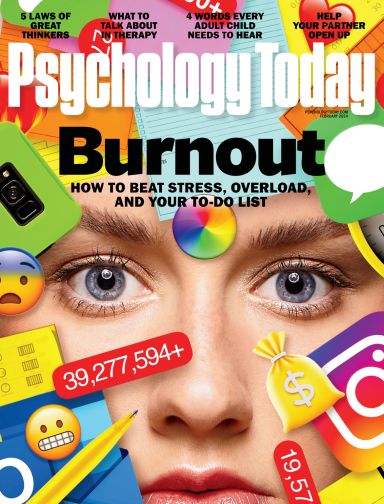Friends
Even Strong Hearts Can Break
Broken hearts don't mend on their own.
Posted April 15, 2021 Reviewed by Kaja Perina
Key points
- A "broken heart" is known medically as Takotsubo's cardiomyopathy and it can hit women over 55 particularly hard.
- Anecdotal evidence suggests that a long-term project can help people with chronic illness, which can include a broken heart.
- You can "hear" the presence of a broken heart and, when it evokes your empathy, act on your love of that person.
- A broken heart can cause acute pain, chronic pain, or both.
The process might be slow or fast, causing chronic or acute pain, but people can die of a broken heart. Here are two short stories of broken hearts, along with insights that might help you support someone you know who is suffering from the loss of a significant relationship.
First of all, I want to share important physiological background on a broken heart from Dr. Suzanne Steinbaum, author of a book that bears her name and her wisdom about hearts. Next, I want to answer a natural question from you: Why this blog post now? The answer is within story #1.
Dr. Steinbaum says, “The most dramatic example of the link between stress and the body is a condition called Takotsubo’s cardiomyopathy, or broken heart syndrome. Broken heart syndrome is really the ultimate experession of stress in the body.” Dr. Suzanne Steinbaum’s Heart Book goes on to explain that it can be fatal, and that women older than 55 have an increased risk.
Both women in the following stories fell into the group of “increased risk.”
Story #1: Marti Benedetti
A check arrived in yesterday’s mail and I cried. The check was a payment to two of my agency clients, the writing team behind Finding Love After Loss: A Relationship Roadmap for Widows, which will be released by Rowman & Littlefield in October. One half of that team, Marti Benedetti, died three weeks ago. Her writing partner, Mary Dempsey, had phoned me shortly after that to let me know.
Marti led a healthy, active life, with Mary remembering that she “biked everywhere and was the kind of person who could sit on the floor cross-legged and then stand up without using her hands.” The last thing her family and friends expected to associate with her was heart trouble.
And then Marti’s husband Tom died. Shortly after that, she had to have heart surgery. She admitted in her blog, LifeAfterWidowhood, that she had a broken heart—literally. She seemed to recover, but next was stricken with cancer. She pushed through it long enough to finish the book with Mary and to see it posted online as available for pre-order.

Mary thought about the events of the nine years between Tom’s death and Marti’s, primarily focusing on the years they collaborated on Finding Love After Loss. She asked herself a big question:
Does having a long-term project help people with chronic illness?
If we look at Marti’s broken heart as a chronic illness, as well as the cancer that ultimately got tagged as her cause of death, then the shared objective of publishing the book may well have extended Marti’s life. Mary says,
"Marti's situation made me wonder if having some big focus beyond health management improves the quality of life for people with long-term illnesses. Specifically, I wondered if having a big goal—our widowhood dating book—helped Marti define herself beyond her illness and feel like she was doing something valuable for the bigger world."
The book project also involved a critical interaction that may have fueled Marti’s desire to live a little longer:
"For four years, Marti and I had regular 9 am phone meetings every Thursday. We discussed the book each week—work we were doing, research ahead, interviews on our schedules, editing needed, and so on. Then we chatted at the end of the meeting about what was going on in our personal lives. Some of her friends have said she frequently mentioned that standing meeting, and they now wonder if the commitment gave her a guaranteed and steady connection during times when illness might have isolated her."
Story #2: Chris F.
When she got pregnant while still in high school, Chris dropped out to marry her boyfriend and raise a son. The boyfriend-turned-husband flirted with one of Chris’ friends at the wedding—a good indication of why the marriage had a short life.
Chris raised her son as a single mom. Their bond remained strong until he died of cancer at the age of 39.
Chris had lost touch with many of the people she knew in high school. While they had their reunions every five years, she was out of the social loop. But when her son passed away, she located people she had been close to. She called them.
I was one of them. When I heard her voice after all those decades, I was thrilled she had tracked me down, despite the fact I’d moved dozens of times since our childhood. She told me all about the kind and brave things her son had done during his life and how much she missed him.
A broken heart is something anyone with a speck of empathy can hear. I heard it, but I can’t give myself any credit for responding appropriately. I did almost nothing to restore our relationship and sustain a connection. It was Chris reaching out to me and to other old friends—and I don’t think we reached back nearly enough.
Chris passed away one day after Marti Benedetti.
Broken hearts don’t mend on their own. As in Marti’s case, they sometimes require a surgeon, but in every case, they require loving friends who keep showing up and making a healthy connection.
References
Steinbaum, Suzanne, MD. Dr. Suzanne Steinbaum's Heart Book: Every Woman's guide to a Heart-Healthy Life. New York, NY: Avery




